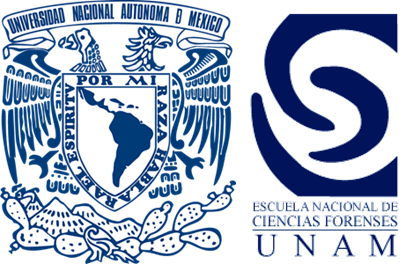Biblioteca Digital: Sexto Semestre
Bibliografía para el sexto semestre, de acuerdo al plan de estudios
-
Hematología y Serología Forense
-
Bibliografía básica:
- 2011. Histología con correlaciones funcionales y clínicas.|° Ed. Lippincott. (Físico)
- Gerald . 2011. Biología Celular y Molecular. 6°Ed. México. McGraw Hill. Interamericana. (Físico)

- Houck M.M. Siegel J.A. (2010). Fundamentals of Forensic Science. China: 2nd Ed. New ecr: Elsevier. (Físico)

-
Bibliografía complementaria:
- Vargas (2009). Atlas de Ciencias Forenses. 1ª. Ed. México: Trillas. (Físico)
- Cole T. (1992). American System of Criminal Justice. 6th ed. California: Brooks Cole. (Físico)
-
Medicina Forense
-
Bibliografía básica:
- Simonin C.L. (1980) Medicina Legal Judicial, Ed. Lehmann. Costa Rica. (Físico)
- Gisbert Calabuig J.A. (1998) Medicina Legal y Toxicología, Ed. Masson. España. (Físico)
- Vargas (2009). Atlas de Ciencias Forenses. 1ª. Ed. México: Trillas (Físico)
- Alba M. (2001). Medicina Forense México: Trillas.
-
Bibliografía complementaria:
- Téllez Rodríguez,.N.R (2002). Medicina forense: manual integrado. Colombia: Universidad de Colombia.
- Romo Pizarro, O. (2000). Medicina Legal. Elementos de las Ciencias Forenses Chile: Jurídica de Chile. (Físico)
- Clinical Forensic Medicine (Springer)
-
Sexología Forense
-
Bibliografía básica:
- Simonin C.L. (1980) Medicina Legal Judicial, Ed. Lehmann. Costa Rica. (Físico)
- Gisbert Calabuig J.A. (1998) Medicina Legal y Toxicología, Ed. Masson. España. (Físico)
- Vargas E. (2008). Sexologìa forense/Forensic Sexology México: Trillas. (Físico)
- Silva, H (2001) Medicina Legal y Psiquiatria Forense Chile: Jurídica de Chile. (Físico)
- Krivacska, J.J. Money, J.(1994). The handbook of forensic sexology USA: Prometheus books. (Físico)
-
Bibliografía complementaria:
- Money, J. (1997). The Principles of Developmental Sexology. USA: Continuum. (Físico)
- De Zapien, R.H. (2004).Apex Forensic Pathology Vocabulary Glossary and Workbook for Interpreters. Rosie Zapien.
- Forensic Investigation of Sex Crimes and Sexual Offenders (Elsevier)
- Suicide Among Child Sex Offenders (Springer)
-
Entrevista Psicológica Forense
-
Bibliografía básica:
- Paker Martín (2007). Psicología Interpretativa. En: Aguilar, Miguel A. Reid, A. Tratado de psicología social: perspectivas socioculturales. España: Anthropos. p. 338.344.
- Fernández, R. (2004). Evaluación Psicológica: Conceptos, métodos y estudio de casos. Madrid: Pirámide. (Físico)
-
Bibliografía complementaria:
- Cicero, M. Moreno, S. (2000). Teoría y Técnica de la Entrevista. México: Impromar. (Físico)
- Díaz. I. (1994). Técnica de la Entrevista Psicodinámica. México: Pax. (Físico)
- Etchegoyen, H. (2002). Los Fundamentos de la Técnica Psicoanalítica. Buenos Aires: Amorrortu. (Físico)

- Franca-Tarragó, O. (2005)- Ética para Psicólogos. Introducción a la psicoética. (5ª ed.) Bilbao: Descleé De Brouwer. (Físico)

- Gabbard, G. (2002). Psiquiatría Psicodinámica en la Práctica Clínica. Madrid: Médica Panamericana. (Físico)
- Garrido E., Masip J. Herrero M. (2006.) Psicología Jurídica.: España: Pearson, Prentice Hall. (Fïsico)
- Machiori H. (1990). Psicología Criminal. México: Trillas.
- PTSD and Forensic Psychology (Springer)
- Handbook of Forensic Sociology and Psychology (Springer)
- Forensic Neuropsychological Evaluation of the Violent Offender (Springer)
- Forensic Epidemiology in the Global Context (Springer)
- Handbook of Juvenile Forensic Psychology and Psychiatry (Springer)
- Serial Murder and the Psychology of Violent Crimes (Springer)
-
Delitos Cibernéticos
-
Bibliografía básica:
- Berengue, E.O. Roig Torres, M. (2001). Delitos Informáticos y Delitos Comunes Cometidos a Través de la Informática. México: Tirant Lo Blanch. (Físico)
- Piña Libien, H.R. (2001). Los Delitos Informáticos Previstos y Sancionados en el Ordenamiento Jurídico Mexicano. México: Trillas.
- Derecho Informático (2004). 3ª ed. México: Mc Graw Hill. (Físico)
-
Bibliografía complementaria:
- Derecho Informático (1996).2ª ed. México: Mc Graw Hill. (Físico)
- Código Penal Federal (2009). México: Porrúa. (Físico)
- Código Penal del Estado de Sinaloa. (2010). México: Porrúa. (Físico)
- Jurisconsulta (Mayo 2007) Con Legislación Federal.
- iOS Forensic Analysis for iPhone, iPad, and iPod touch (Springer)
- The Basics of Digital Forensics (Elsevier)
- Windows Forensic Analysis Toolkit (Elsevier)
- Mobile Phone Security and Forensics (Springer)
- Cybercrime, Digital Forensics and Jurisdiction (Springer)
-
Antropología Forense
-
Bibliografía básica:
- Bogin, Barry, 1999 Patternsof human growth, second edition, Cambridge, Cambridge University Press
- Hawkes, Christineand Richard R. Paine (editors), 2006 The evolution of human lifehistory, Santa Fe and Oxford, School of American Researchand James Currey
- Komar, Debra y Jane Buikstra (editors), 2008 Forensic anthropology, contemporary theory and Practice, Oxford, University Press, Nueva York. (Físico)
- Mielke, James H., Lyle W. Konigsberg y John H. Relethford ,2001 Human biological variation, second edition, New York y Oxford, Oxford University Press, (Físico)
- Ortner, Donald J., 2003 Identification of Pathological Conditions in Human Skeletal Remains. Academic Press, San Diego. (Físico)

- White, Tim, Michael T. Black y Pieter A. Folkens, 2011 Human Osteology, Academic Press, San Diego (Físico)

-
Bibliografía complementaria:
- Bass, William, 1995. Human Osteology: A Laboratory and Field Manual, Fourth Edition. Columbia, Missouri: Missouri Archaeological Society. (Físico)
- Buikstra JE y Ubelaker DH, (editors), 1994 Standards for Data Collection from Human Skeletal Remains. Fayetteville: Arkansas Archeological Survey. (Físico)
- Krogman, Wilton Marion y Mehmet Yaşar Işcan, 1986. The human skeleton in forensic Medicine. Springfield, Illinois: Charles C. Thomas. (Físico)

- Reichs, kathleen J. (Editora), 1998. Forensic Osteology: Advances in the Identification of Human Remains, Second Edition. Springfield, Illinois: Charles C. Thomas, Ltd. (Físico)

- Research Methods in Human Skeletal Biology (Elsevier)
-
Métodos de Investigación de los Hechos Ocasionados por Proyectil de Arma de Fuego
-
Bibliografía básica:
- Houck M.M. Siegel J.A.(2010). Fundamentals of Forensic Science. 2nd. Ed. China: Elsevier. (Físico)

-
Bibliografía complementaria:
- Cole, G. (1992).The American System of Criminal Justice. 6th Ed. California: Brooks / Cole. (Físico)
- Hernández M. (2010). Glosario Técnico de los accidentes de tránsito: Manual básico de hechos de tránsito terrestre. Flores Editor. (Físico)
- Wound Ballistics (Springer)
-
Métodos de Investigación de los Hechos de Tránsito (Aéreo, Náutico y Terrestre)
-
Bibliografía básica:
- Flores C. (1995) Hechos de Tránsito Terrestre. México: Porrúa.
-
Bibliografía complementaria:
- Hernández M. (2010). Los accidentes de tránsito: Manual Básico de Investigación de hechos de tránsito 3. Flores Editor (Físico)
- Practical Aviation Security (Elsevier)






